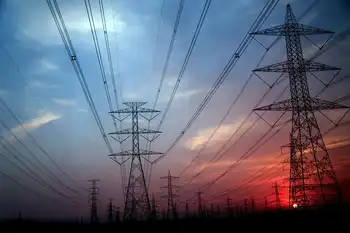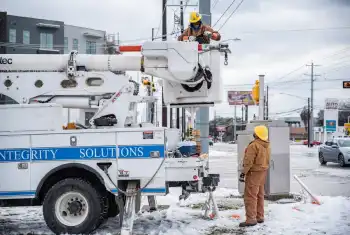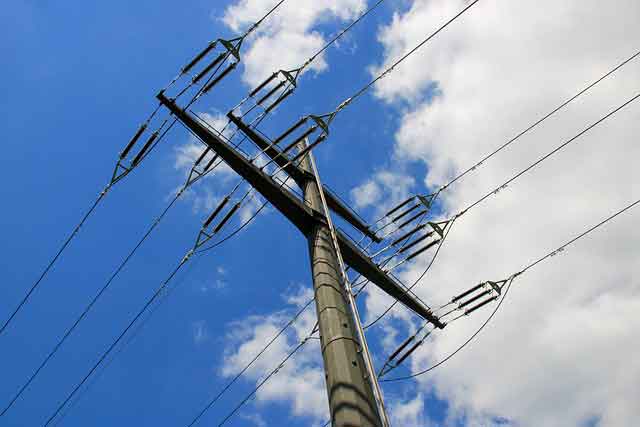Renewable sector offers careers in tough times
By Vancouver Sun
Protective Relay Training - Basic
Our customized live online or in‑person group training can be delivered to your staff at your location.

- Live Online
- 12 hours Instructor-led
- Group Training Available
The 32-year-old Castellan signed on with City Green Solutions eight months ago as a certified energy advisor. He visits all kinds of Metro Vancouver homes, giving advice on everything from the financial advantages of solar panels to the efficiencies of ground-source heat pumps, which are powered by electricity.
Castellan is part of a sector thatÂ’s bucking the trend of the economic downturn. ItÂ’s expected to have plenty of work in the coming years.
“This [the electricity and renewable energy sector] is an industry [in which] I think there will be long-term growth regardless of what the economy does,” Castellan said in an interview. “Despite the downturn, it continues to grow moderately. There’s a big shift towards [more] electricity in the home. And this is something I’m passionate about.”
Castellan, whose employer is a Victoria-based non-profit society that does home energy assessments throughout the province, said his job doesnÂ’t involve installing anything.
Rather, he measures homes and sets up models to do heat-loss calculations.
“And since I was hired, City Green has gone through another round of hiring.”
Blair Lekstrom, provincial minister of energy, mines and petroleum resources, recently announced with the Electricity Sector Council the launch of Bright Futures BC, a skilled-labour career-awareness program for the electricity industry.
Lekstrom said in an interview the electricity and renewable energy sector needs skilled workers to ensure continued growth.
“We think the future’s bright,” Lekstrom said. “The trades are every bit as important as getting a university degree. Conservation is one part of the reason, [and] demand for electricity is going to grow. And [the grid] has to be maintained. There’s an aging workforce. We see a real need and focus to bring new people along.”
According to the ministry of energy, mines and petroleum resources, one-third of the skilled workers in B.C. will be ready to retire in the next decade. It is estimated that in 2009, 57 per cent of provinceÂ’s power-systems operators will retire, with an additional 21 per cent retiring by 2012.
Estimated retirement rates for civil engineering technicians are 11 per cent in 2009 and 15 per cent in 2012, and for civil engineers, they are 13 per cent and eight per cent, respectively.
A ministry release also stated that B.C. has a wealth of post-secondary training — including apprenticeship technical training programs — to prepare youths for a career in the electrician and electrical engineering fields.
“Between now and 2014, the equivalent of about one-third of the workforce is on its way out the door,” Catherine Cottingham, executive director and CEO of the Electricity Sector Council (an independent organization funded by the government of Canada), said in an interview. “There are all kinds of opportunities.”
Cottingham said there is already a shortage of power-line workers. “There’s been a shortage in B.C. for two years. And it’s a very well paid job.”
Other trades in the industry with a bright future, she said, are systems operators, energy auditors, electricians and installers of solar panels.
She said there will also be a lot of infrastructure work needed in the coming years — and people are needed to do it.
But itÂ’s not just the electricity and renewable energy sector that will need a lot of new workers in the coming years.
With the recession increasingly bearing down on the economy, large numbers of workers are starting to feel its effects.
But some sectors are expected not only to survive, but to thrive in the future, with plenty of growth and more than enough work to go around.
Nursing is a major growth area, thanks to an aging population and many retirements on the horizon.
And while primary and secondary school teachers arenÂ’t finding full-time work as readily as theyÂ’d like, thatÂ’s expected to change within five years as older teachers retire. As well, teachers who specialize in certain areas are having a far easier time finding work.
Other professions that are expected to stay in demand include IT analysts, accountants, social workers, telecom specialists, sales representatives and home-care providers for an aging population.
As well, mechanics should fare reasonably well because fewer people are buying new cars, instead holding on to their old ones, which need maintenance.
On the flip-side, with companies tightening their business lunch belts and more people eating at home these days, now might not be the best time to become a chef.
And if youÂ’re interested in a job navigating the roads, Statistics Canada reported 30,000 fewer jobs in trucking and warehousing across Canada in January.
Other high-opportunity prospects, according to a report by Service Canada and the B.C. Ministry of Advanced Education, are civil engineers, architects, pharmacists, translators and interpreters, medical workers including medical lab technologists, health care and human resources managers and machine tool operators.
As well, a Canadian Labour Market Outlook report for Human Resources and Skills Development Canada, covering 2006 to 2015, concluded that over the next decade, employment growth in the service sector is expected to outpace that in the goods-producing sector.
The report noted that with the retirement of many baby boomers, most job openings will stem from the need to replace retired workers.
But if youÂ’re thinking of leaving school, think again. The report said that most job openings are expected to be in occupations usually requiring post-secondary education (university, college or apprenticeship training).
Another Service Canada survey listed nearly 50 occupations with good job prospects in 2009. They included: ambulance attendants, dentists and dental assistants, family, marriage and other related counsellors, doctors, public and environmental health inspectors, judges and lawyers, mechanical engineers, optometrists, dietitians and nutritionists, university professors, technical inspectors and regulatory officers.
Meanwhile, a recent survey by Manpower Inc. concluded that while Vancouver employers are more likely to cut back staff than hire in the next few months, there are still jobs to be had in the right sector.
The survey found that employers in different industries had different expectations. Across Western Canada, the net employment outlook for services was 20 per cent, and for public administration 15 per cent — indications many employers in those sectors planned to hire, not fire.
The most pessimistic employers were in finance and construction. In Western Canada net employment outlooks in those fields are two per cent, which means the number of employers intending to hire outnumbered those who planned to fire by only two per cent.
Victoria resident Erin Mowat is a nurse who has just competed her practicum. She believes her future prospects are as solid as a rock.
“When I first decided that I wanted to be a nurse, I was told that everybody needs nurses,” Mowat said in an interview. “And it’s true. There’s such an amazing opportunity. You can go anywhere and do anything.”
Mowat, who left a career as a marine-engineering system operator with the Canadian navy, said she always knew she wanted to be a nurse. “I feel like I had a calling to nursing.”
Mowat is particularly interested in pediatric nursing and is now being interviewed for jobs, having completed her Bachelor of Science in nursing at Camosun College and the University of Victoria. “It’s the only thing I’ve ever been truly sure of in my life, as far as professions go.”
Rod OÂ’Connell, director of recruitment and retention for the Vancouver Island Health Authority, which has 17,000 employees, said in an interview that people like Mowat will have no trouble whatsoever finding good jobs.
“In general, there are no unemployed health care workers,” said O’Connell, himself a former nurse. “We hire pretty much every graduate. We have 5,500 nurses and last year, we hired 220 new graduates, as well as experienced workers.”
O’Connell said it’s not just nurses who are in demand in the medical field. “Physiotherapists, occupational therapists, social workers, pharmacists are highly in demand. Some are in competition with the private sector.
“And Canadian nurses are probably the best trained in the world. They can go and work anywhere in the world.”
O’Connell said there are two reasons for the demand: an aging population that’s putting pressure on the health care system and an aging medical workforce that’s set to retire. “Last year, we had a net gain of 900 employees. We hired 2,400 staff and 1,500 left.
“And we’re only one of six health authorities in B.C. [The others] are the same.”
OÂ’Connell noted that trained nurses start at more than $29 an hour and make more than $38 an hour after eight years. As well, he said, they can make additional pay, including an extra $6.50 an hour for working weekend night shifts.
While jobs arenÂ’t readily available these days for regular elementary and secondary teacher graduates, thatÂ’s expected to change over the next several years as thousands of todayÂ’s teachers retire.
In the meantime, according to a University of B.C. official, thereÂ’s plenty of work for young teachers who specialize in a specific area.
“Now, [the number of new jobs] is modest,” Gary Rupert, program coordinator of UBC’s bachelor of education program, said in an interview. “But we anticipate jobs will open up within the next five years as people retire. Many start out as a teacher on call, but they usually get a job within a year, either full-time, part-time or job-sharing.”
Despite that, Rupert said the future looks good, partly because Canada is expected to retain strong immigration levels.
“They [immigrants] tend to have larger families. And there’s also the potential of all-day kindergarten. If that happens, there will be a sudden demand for primary teachers.”
However, Rupert said there remains a strong demand for teachers who specialize in certain areas, including applied technology, home economics, physics and chemistry, math, special education and English as a second language. “And there’s always a demand for teachers of French.”
Rupert said there’s a growing need for teachers of the Chinese language. “We’ve even had calls from the U.S. [for these teachers].”
As well, he added, a growing number of new teachers are going to other jurisdictions and countries as a “work/adventure” experience to get their first taste of teaching.
“The first thing I recommend is that [new teachers] get experience with young people of different ages. They need a broad-based academic education. And any specialization you have advances your prospects.”
One aspiring teacher who is looking ahead is Maribeth Ching, who is in her second year at UBCÂ’s elementary teacher program and is specializing in EAL (English as an additional language).
“I knew I wanted to go into teaching and I wanted to equip myself with as much skills and training as I could,” said Ching, a 23-year-old Richmond resident. “I’m going to apply to Richmond school board and I chose EAL to hopefully meet their needs.”
Ching noted that a large number of students in both Richmond and Vancouver don’t have a great grasp of the English language. “This will help me give them the resources they need.”











